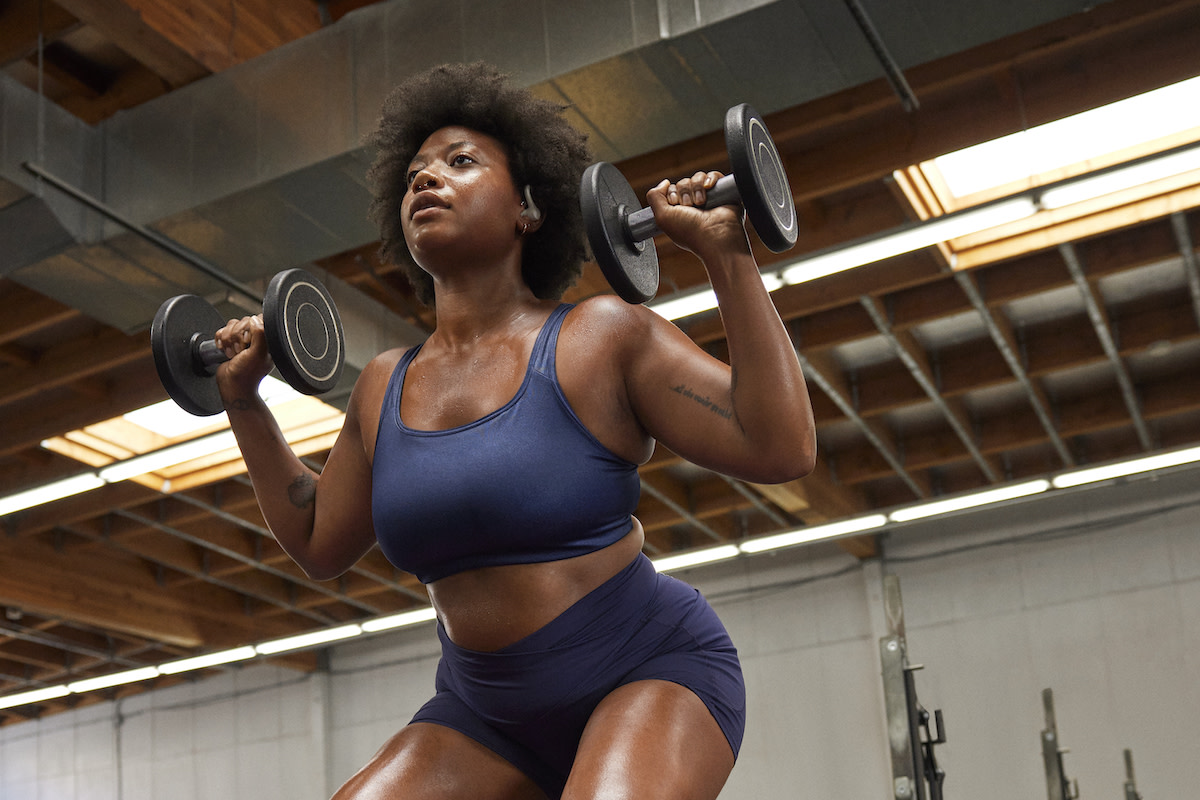The Full Body Workout, Explained
Can You Do a Full Body Workout Every Day?
How to Warm Up for Full Body Training
Benefits of Full Body Workouts
Types of Full Body Workouts
5 Full Body Exercises to Try
If you’re busy and looking to maximize your time, you want an efficient workout that hits all your major muscle groups and gives you that blissful just-worked-out endorphin high. But what gives you the best bang for your buck? It seems like every time you turn around, there’s a new “expert” claiming to have the “perfect” workout. If you’re overwhelmed by the firehose of fitness information out there, we get it.
That’s why we’re covering everything you need to know about full body workouts, including what they are, what they aren’t, and some of the best and exercises out there, including insights from Peloton instructor Callie Gullickson.
The Full Body Workout, Explained
You’ve probably heard the term “full body workout” dozens of times. But what does that actually mean? Keep reading for the real deal on what a full body workout is—and isn’t.
A full body workout works all the major muscle groups in your body, rather than focusing on just one body part. For instance, the Peloton App offers Arms & Shoulders classes. While they’re great workouts for building your upper body strength, because they primarily focus on muscles like your shoulders, traps, and biceps, they wouldn’t be considered a full body workout.
Thinking about taking a Core Strength class? Again, these are fun, effective workouts that definitely deserve a spot in your routine, but if it’s only targeting your core, obliques, and lower back, it’s not considered a full body workout.
While your full body workout can include aerobic exercise, resistance training, or a combination of the two, it should engage all or most of the following major muscle groups:
Chest
Back
Shoulders
Glutes
Legs
Core
If you’re focused on strength training, it’s important to understand what people mean when they refer to full body training versus split training. Split training refers to creating workout routines that target different muscle groups on different days. A traditional five-day split training schedule might look something like this:
Monday: Chest
Tuesday: Back
Wednesday: Legs
Thursday: Shoulders
Friday: Arms
Saturday: rest or active recovery
Sunday: rest or active recovery
The idea is to put in a high-quality effort before your muscles fatigue—and presumably, you’ll be able to, since you’re coming into the workout with the target muscle group fully rested. Upsides of split training include shorter workouts, since you’re only targeting one muscle group, and a more intense workout. Because you have more time to focus on one specific muscle group, you can perform multiple different exercises to challenge it in slightly different ways. (For example, you might work your biceps with sets of both traditional biceps curls and hammer curls.) Downsides include the fact that if you miss a day, you could easily go two weeks without working a certain muscle group if you’re doing a five-day split.
Full body training, on the other hand, includes exercises that hit every major muscle group and give you at least a day of rest between workouts. A typical workout might include dumbbell rows, chest presses, deadlifts, squats, overhead presses, and some core exercises. Upsides of full body workouts include the fact that even if you miss a day, you’re still hitting every major muscle group multiple times per week, your heart rate during your session will typically be higher than if you were targeting a single muscle group, and avoiding strength training on back to back days can mean spending less time getting to and from the gym. As for downsides, full body workouts can take more time and can set you up to feel fatigued or sore for your next ride, run, or other cardio session.

Peloton App
Access thousands of classes with no equipment needed.
Can You Do a Full Body Workout Every Day?
While you certainly can do a full body workout every day, that doesn’t mean you should. “Engaging in a full body workout every day might feel good and empowering at first, but it’s just not sustainable,” says Callie. Doing the same type of workout every single day puts you at risk of injury and burnout.
And while it might seem counterintuitive, doing too much of the same thing can actually stall your performance improvements. “Don’t be surprised if you see a performance plateau after hitting the same muscle groups every single day. When your workout is hard enough to elicit muscle tissue breakdown, it will rebuild stronger—but only if you give yourself time to recover between sessions,” says Callie.
Generally speaking, you’ll get the most out of your full body workouts by putting at least 48 hours between them. And while most trainers recommend taking one day fully off per week, Callie takes that a step further; she suggests taking two days totally off per week. “More isn’t necessarily better. Making sure you give your body plenty of time to rest and recover means you’re less likely to get injured and more likely to go into each workout feeling strong and energized,” she explains.
Of course, your workout routine should work for you. “With that being said, I believe in finding workouts that you enjoy is better than not doing anything,” says Callie.
So if you love your full body workouts and want to do them four or five days a week, be sure to vary the type of workout and the intensity. For example, if you swim hard on Mondays, take your intervals a little easier on Tuesday, or better yet, hit the weights on Tuesday. If you play volleyball on Wednesday nights, make Thursday your power yoga day rather than playing volleyball again. If you’ve done a full body strength training workout one day, try a cardio full body workout the following day (and dial back the intensity if you’re sore from the previous day).
How to Warm Up for Full Body Training
The best warm-up for your full body session engages all or most of the muscles you plan to engage during your workout. But generally speaking, it’s a good idea to do any activity at a gentle or moderate pace that elevates your heart rate for a minimum of three to five minutes before you dive in. That could be a brisk walk, an easy jog, jumping rope, or even cycling. If you’re lifting weights, it’s never a bad idea to perform a warm-up set of whatever movement you’re about to do using only your body weight or much lighter weights than plan to use during your workout.
Benefits of Full Body Workouts
Full body workouts offer plenty of benefits, including the opportunity to get a lot done in a short period of time, which is especially important for people who have limited time to devote to fitness.
“Full body workouts engage every major muscle group in your body—which means you’re recruiting muscle fibers throughout your body—and therefore expending more energy. And if you’re adequately rested, hydrated, and nourished, your body will recover from that effort even stronger and fitter,” says Callie.
In addition to boosting your fitness, full body workouts are also functional and can help you avoid injuries and enjoy an active lifestyle. “Engaging all of the major muscle groups ensures you’re not overworking some muscles while ignoring others, which can lead to imbalances that, over time, can lead to chronic pain and even limited joint mobility,” says Callie.
For example, you might tack a few sets of crunches and pushups onto your morning run. While it’s great to add some strength training to your routine, if you never work the opposing muscles that are often known as your posterior chain, including your lumbar extensor muscles and latissimus dorsi, your posture and overall upper body strength will suffer.
Because full body workouts typically involve compound movements, or exercises that require movement at more than one joint, these movement patterns are a form of functional fitness. In other words, your triceps dips and triceps dumbbell kickbacks might develop your triceps beautifully, but those single-joint movements can’t simulate the demands of everyday tasks like shoveling snow, lifting a Costco-sized bag of dog food, or lifting a child from the ground to your hip. It’s the compound movements you find in many full body workouts, including squats, deadlifts, chest presses, and overhead presses, that mimic the demands of everyday life and will keep you moving well even as you age.
Types of Full Body Workouts
If you’re interested in exploring full body workouts, there’s no shortage of options. Not sure what kind of full body workout would be ideal for you? Here are a few ideas to get you started.
Rowing
Rowing is a full body workout that doubles as fantastic cardio. It works muscles in your back, shoulders, arms, core, hips, and legs. If you’re a beginner rower, it’s not a bad idea to take a guided rowing class with a professional to make sure your proper rowing form is good in order to avoid low back issues and to optimize your efficiency and power output.
Swimming
Like rowing, swimming relies heavily on technique—but once you have the basics dialed in, there’s nothing better than gliding powerfully through the water. The low-impact sport engages muscles in your back, shoulders, arms, core, hips, and legs
Resistance Training
You can use bodyweight, resistance bands, dumbbells, barbells, and more, or even household items (think: lunges while wearing a heavy backpack or lifting full gallon jugs of water) to target any and all of the muscles in your body with a resistance workout. Not only does building muscle make you stronger and less prone to injury, it also helps build bone density, which is especially important as you age.
Dancing
Depending on what type of dance you engage in and how intense you’d like your session to be, there’s plenty of wiggle room to make your dancing work for you. But dancing can potentially engage every muscle in your body. Plus, if you’re learning a new routine or style of dance, it has the added bonus of engaging your mind, too. (Pro Tip: Peloton Members can check out dance cardio classes on the Peloton App.)
High-Intensity Interval Training (HIIT)
There are dozens (if not hundreds) of ways of approaching a HIIT workout, but they all have one thing in common: there’s a short period of intense exercise (generally 20 to 40 seconds) followed by a period of total recovery. “To get the best workout, you really want to be going all out for, say, 20 seconds and recovering for 40 seconds. If you’re doing it right, that 40-second rest will go by very quickly,” says Callie.
5 Full Body Exercises to Try
If you want to stick with strength training, these full body exercises are tried and true.
1. Dumbbell Thrusters
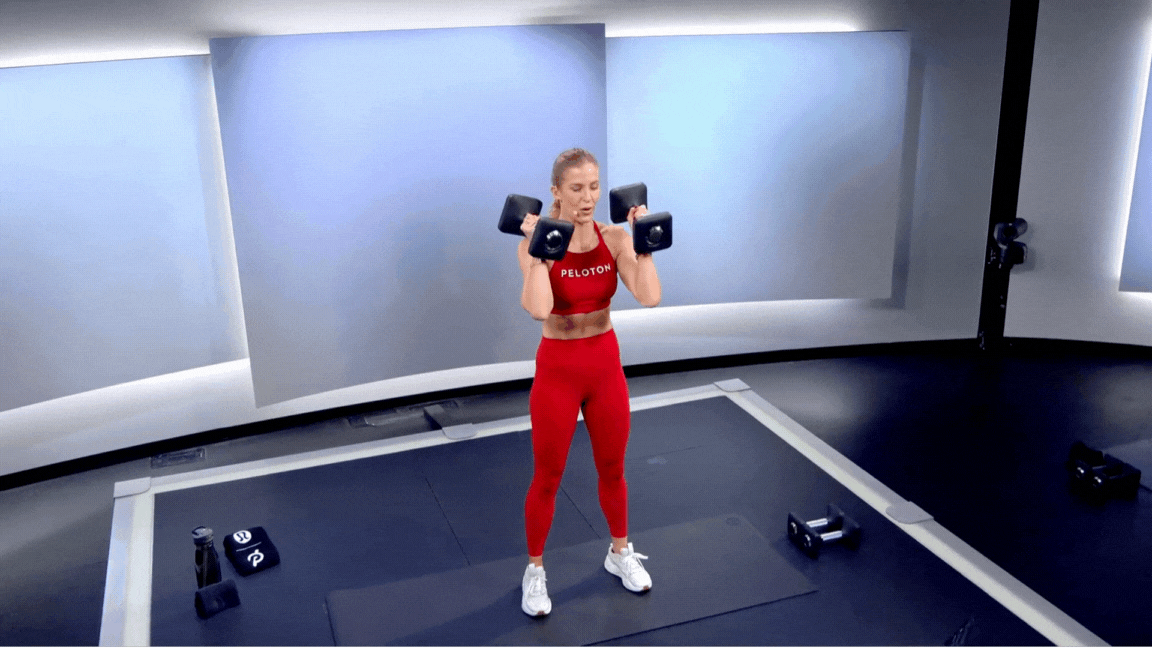
1. Lower down into a squat, keeping weight on heels, while holding your dumbbells at shoulder height with your elbows flexed.
2. As you come to a stand, press your dumbbells overhead until your elbows are fully extended.
3. Lower the dumbbells back to your shoulders and repeat.
4. Remember to keep your core engaged throughout the entire movement.
Muscles worked: Legs, shoulders, and core
2. Mountain Climbers
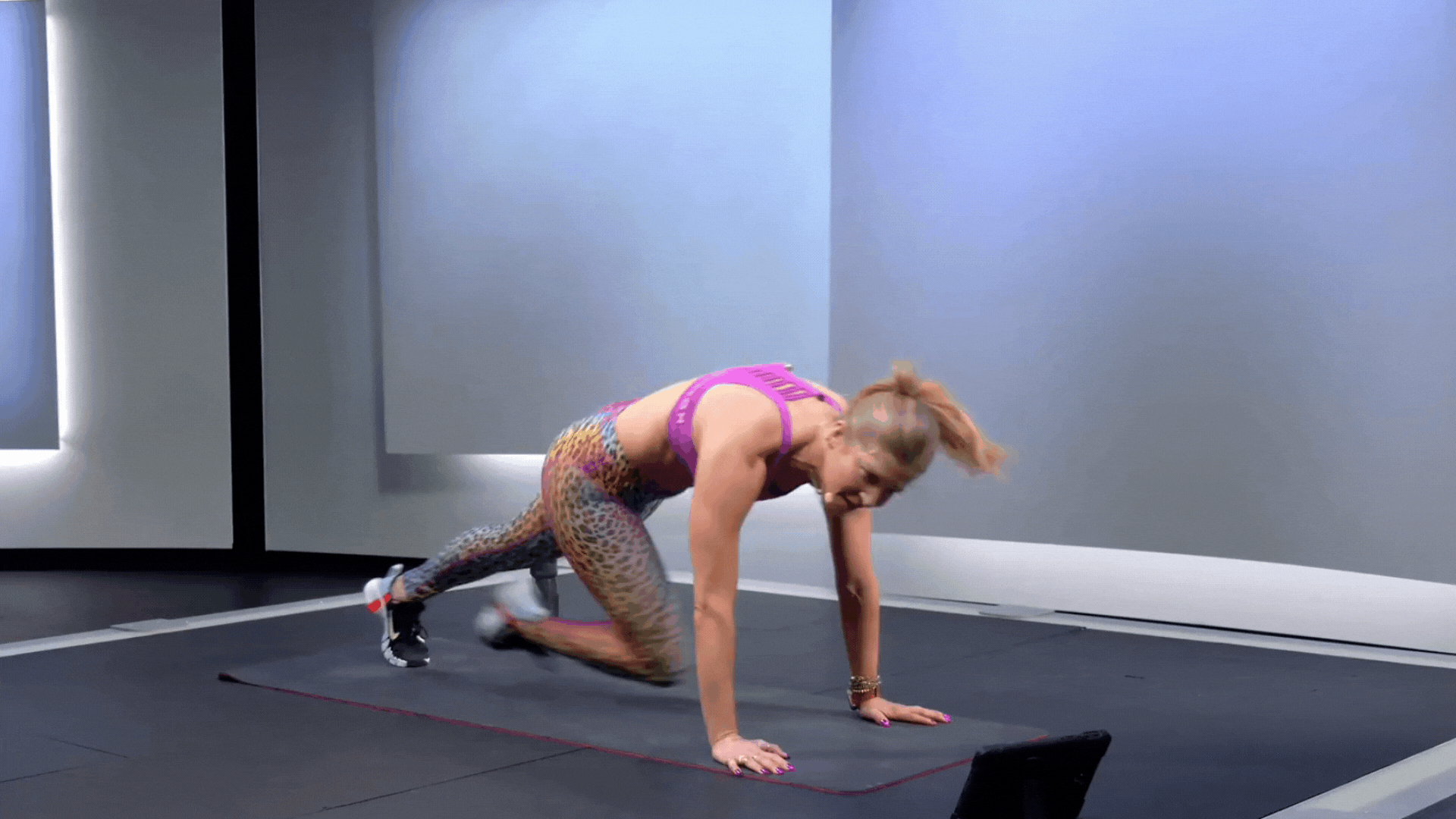
Start in a plank position with your hands directly under your shoulders.
Engage your core and bring one knee toward your chest, then quickly switch legs by jumping and extending the other knee.
Maintain a rapid, alternating motion, keeping your hips low and back straight. Avoid letting your hips sag toward the floor.
Muscles worked: Core and upper body
3. Renegade Rows
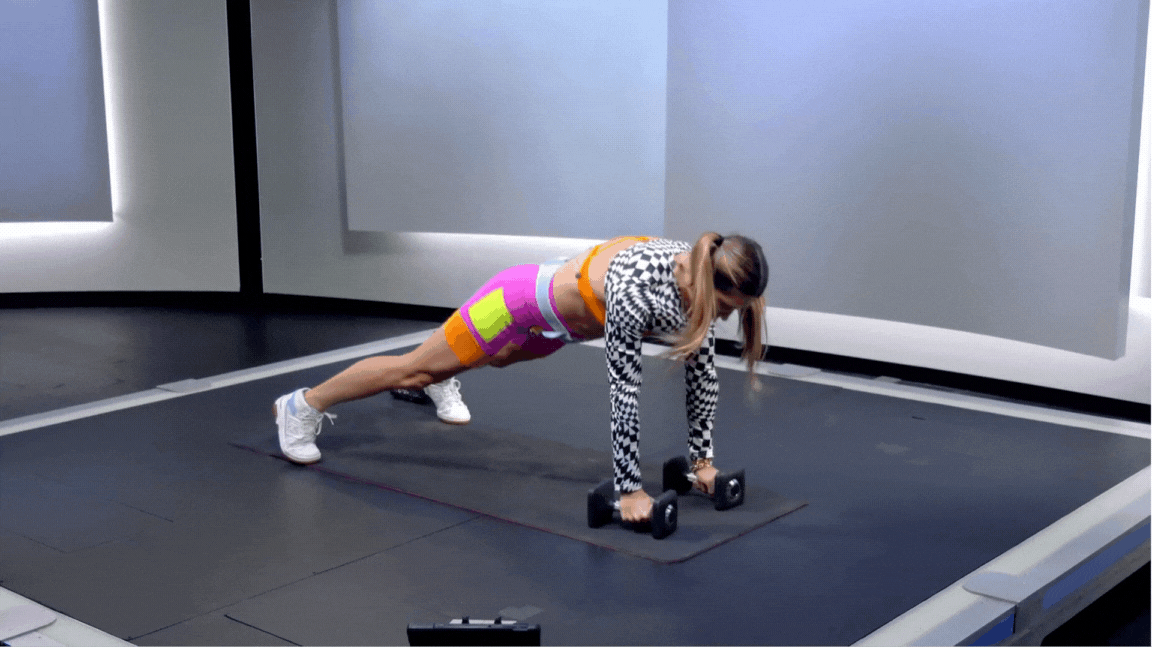
Start in a plank position with a dumbbell in each hand with your wrists directly under your shoulders.
Row one dumbbell up to your chest while balancing on the opposite arm, engaging your back muscles. Maintain a stable plank position throughout and keep your hips level.
Lower the dumbbell back to the ground and repeat on the other side.
Muscles worked: Back, shoulders, and core
4. Push Press
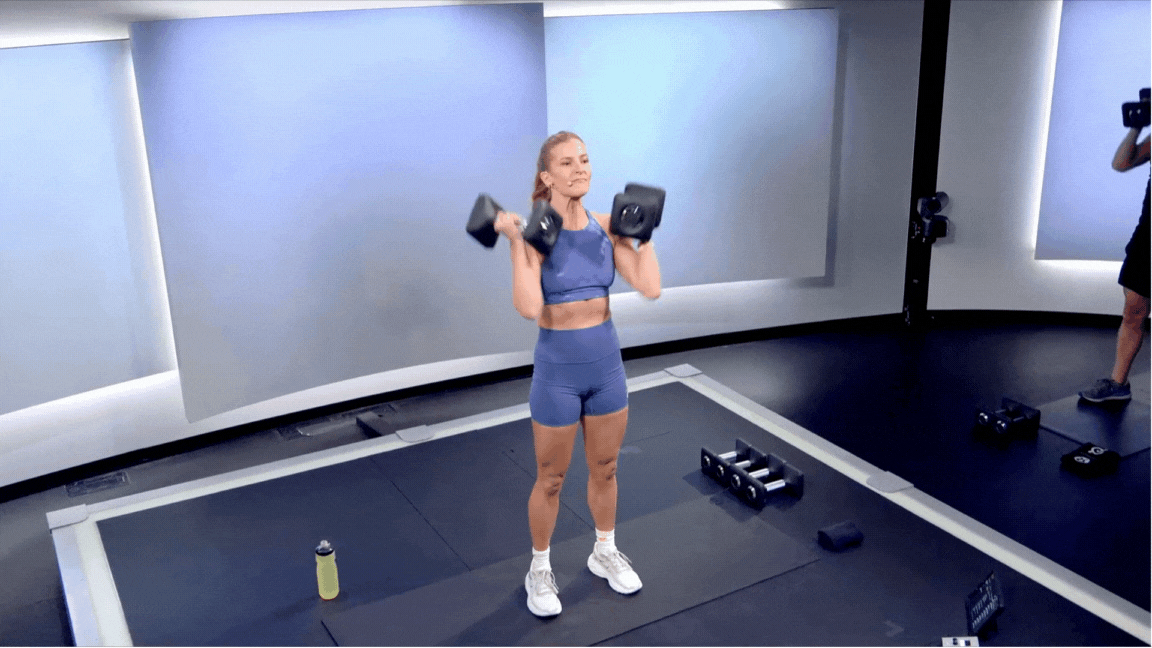
Start with dumbbells at shoulder height and your feet shoulder-width apart.
Grip the weight with your palms facing forward.
Dip your knees slightly, then explosively extend your hips and knees, driving the weight(s) overhead.
As you extend your knees and hips, press the weight overhead using the momentum from your lower body.
Fully extend your arms, bringing the bar or dumbbells directly above your head.
Lower the barbell back to shoulder height with control.
Remember to maintain a tight core throughout to stabilize the movement.
Muscles worked: Calves, glutes, quads, shoulders, triceps, and core
5. Clean
Start standing hip-width apart with dumbbells at your sides, palms facing in.
Hings your hips back with a slight bend in your knees, keeping dumbbells close to your body.
In one motion, push through the floor and extend through your hips as you raise the dumbbells up and rack them in front of your shoulders.
Land with soft knees before coming back to stand.
Return to start. Repeat.
Muscles worked: Glutes, quads, traps, calves, hamstrings, core, forearms
This content is for informational and educational purposes only and does not constitute individualized advice. It is not intended to replace professional medical evaluation, diagnosis, or treatment. Seek the advice of your physician for questions you may have regarding your health or a medical condition. If you are having a medical emergency, call your physician or 911 immediately.
Level up your inbox.
Subscribe for a weekly dose of fitness, plus the latest promos, launches, and events.
By providing your email address, you agree to receive marketing communications from Peloton.
For more about how we use your information, see our Privacy Policy.
